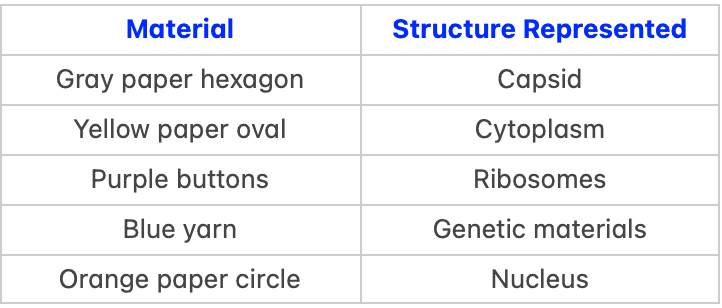
Biology DCP Review
Quiz by Anna Krugjohann
Feel free to use or edit a copy
includes Teacher and Student dashboards
Measures 6 skills from
- edit the questions
- save a copy for later
- start a class game
- automatically assign follow-up activities based on students’ scores
- assign as homework
- share a link with colleagues
- print as a bubble sheet
- Q1
Materials are provided to students to build models of a prokaryotic cell, a eukaryotic cell, and a virus. The materials and the structures they represent are listed in the table shown.
Which material will students use in all three models?
Gray paper hexagon
Purple buttons
Blue yarn
Yellow paper oval
300sBIOL.4c - Q2
Which of these describes a difference between viruses and cells?
Viruses have membranes made of proteins, and cells have membranes made of nucleic acid.
Cells reproduce independently, and viruses require a host to reproduce.
Cells contain protein, and viruses contain only carbohydrates.
Viruses have flagella, and cells only have cilia.
300sBIOL.4c - Q3
Viruses can be transmitted through air, water, food, insect bites, and direct skin contact. Once a virus gains entry to the body, it invades a host cell in order to-
access cellular processes for replication
metabolize host proteins and grow
deactivate the host cell's defenses
synthesize antibodies for defense
300sBIOL.4c - Q4
A model of the genetic control of coat color in rabbits is shown.
Which Punnett square represents a cross that would produce albino offspring?
300sBIOL.6f - Q5
A genetic cross involving two unlinked genes is represented:
AaGG x aaGg
Which genotype is NOT possible in the offspring produced by the cross?
Aagg
aaGg
AaGG
aaGG
300sBIOL.6f - Q6
The inheritance pattern for an autosomal dominant trait is shown in the pedigree. Shaded symbols represent individuals that express the dominant trait.
Based on this pedigree, what are the most likely genotypes of individuals I-1 and I-2?
I-1: aa
I-2: Aa
I-1: aa
I-2: AA
I-1: AA
I-2: Aa
I-1: Aa
I-2: aa
300sBIOL.6f - Q7
Water, sugar, and other important nutrients need to be transported from one part of a plant to another. Which statement correctly describes the interaction of the root and shoot systems during nutrient transport?
The roots take in water and the leaves produce sugar that are transported to the rest of the plant through vascular tissues.
The leaves take in water and the roots produce sugar that are transported to the rest of the plant through vascular tissues.
The roots take in water and sugar, which are then transported to the rest of the plant through vascular tissues.
The leaves take in water and sugar, which are then transported to the rest of the plant through vascular tissues.
300sBIOL.10b - Q8
A flower that has both male and female reproductive structures is shown.
Which statement best describes an interaction that will allow a flowering plant to reproduce by self-pollination?
A pollen grain is transferred form an anther to the stigma of the same flower.
An ovary is transferred from a flower on one plant to a flower on a different plant.
An anther is transferred from a filament to another filament within the same flower.
An ovule is transferred from the ovary to a petal on a different flower.
300sBIOL.10b - Q9
Cytokinins are a class of plant hormones that help regulate growth by promoting cell division. Cytokinins are produced mainly in meristematic tissue, where most plant growth occurs. Which system carries cytokinins produced in the roots to the rest of the plant?
Dermal system
Vascular system
None of these
Reproductive system
300sBIOL.10b - Q10
Researchers have observed striped hyenas and gray wolves hunting together in certain areas. One hypothesis suggests that changing hunting behavior aids both species in obtaining better and more resources. In this hypothesis the hyena's benefit because the wolves chase and take down large animals, such as goats, that the hyenas usually cannot catch alone. The wolves benefit from hyenas using their jaw strength to crack open large bones of prey to access additional nutrients from the bone marrow.
Which table best identifies the ecological relationships among the gray wolf, hyena, and goats?
300sBIOL.12a - Q11
The amount of energy the producers in this energy pyramid provide the primary consumers is 54,000 joules. From this amount, 540 joules are provided to the tertiary consumers.
Based on this model, how much of the energy was provided to secondary consumers?
5,400 J
53,460 J
540 J
54 J
300sBIOL.12c - Q12
The food web shows the flow of energy through a sagebrush-steppe ecosystem.
Which of these organisms are in a trophic level that receives a larger percentage of the energy captured by the producers than the percentage received at the bats' trophic level?
Snakes
Mountain lions
Ground squirrels
Hawks
300sBIOL.12c - Q13
A partial Texas food web is shown.
The populations of which organisms will most likely increase as a result of a disease that suddenly reduced the population of Texas horned lizards?
Texas cottonmouths and red-shouldered hawks.
Grasshoppers and Texas cottonmouths
Grasses and ants
Ants and grasshoppers
300sBIOL.12c - Q14
Some relationships between different organisms are shown in the table.
Which table correctly identifies each type of interaction described?
300sBIOL.12a - Q15
Four common relationships between organisms are listed in the box.
Which statements best describe these relationships?
Relationship 1 is an example of commensalism.
Relationships 2 and 4 are examples of mutualism.
Relationship 3 is an example of predation.
Relationships 1 and 4 are examples of mutualism.
Relationship 2 is an example of commensalism.
Relationship 3 is an example of parasitism.
Relationships 1 and 2 are examples of commensalism.
Relationships 3 and 4 are examples of mutualism.Relationships 1, 2, and 4 are examples of mutualism.
Relationship 3 is an example of parasitism.
300sBIOL.12a
